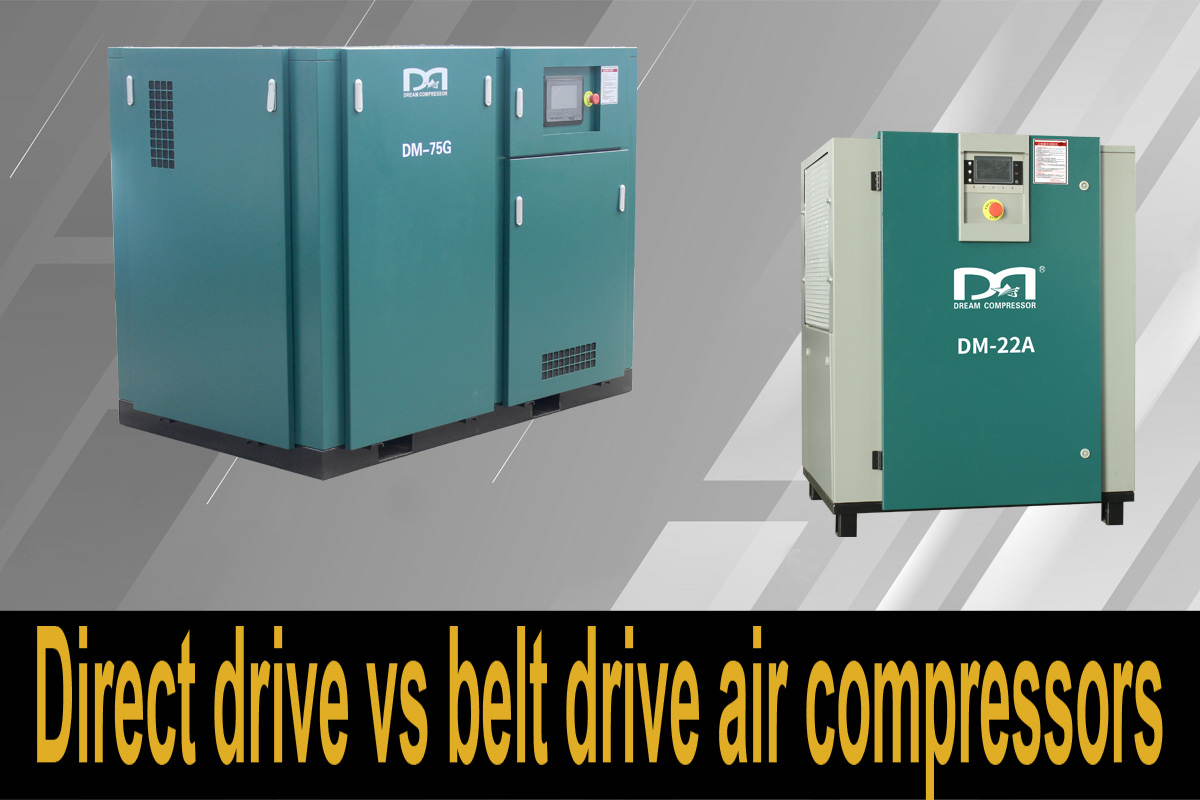
Before we buy an air compressor, we need to understand the difference between belt drive and direct drive air compressor. Choosing the right compressor will optimize the performance of pneumatic tools or pneumatic tools and save us energy and money.
Belt drive and direct drive air compressors are commonly used types of rotary screw compressors. Factors to consider when deciding between these two types include the following:
• Environment
• Flexibility of pressure and speed
• Frequency and duration of use
• Initial cost
• Energy efficiency
• Maintenance
Also consider air pressure pounds per square inch (PSI), cubic feet per minute (CFM), horsepower (HP) and revolutions per minute (RPM), as these factors can impact tool and compressor performance and safety. This is because every tool has specific output and pressure requirements.
What is a Belt Drive Air Compressor?
A belt drive air compressor has a belt that is connected to the motor. When the motor runs, the belt moves the pump through pulleys. The diameters of the pulleys determine the speed and PSI of the compressor.
Pros of a Belt Drive Air Compressor
A belt drive air compressor is a good option for a home workshop. It is also suitable for an indoor shop with multiple work areas. A lubricated belt system will run efficiently, smoothly and quietly, making it less likely to disturb your neighbours.
Flexibility
If you use an air compressor intermittently at various speeds and power, you would probably prefer the flexibility of a belt drive model. For example, you may want to change the pressure from the manufacturer settings.
Your highest rated pneumatic tools may require 100 PSI, but your belt-driven compressor currently operates at 90 PSI. To increase the compressor PSI, you only have to replace the pulley.
The size of the pulleys will depend on the air pressure requirements of the tools you are using, along with HP and RPM. This flexibility makes belt-driven compressors a good choice for woodworking or auto repair shops.
Simple Maintenance
The purchase and installation of a belt-driven air compressor are economical and straightforward. Maintenance is relatively simple for this type of compressor, which generally requires lubrication and monthly belt tension checks. Oil and filter changes are recommended every 500 to 1,000 hours of use.
Cons of a Belt Drive Air Compressor
Wear and tear can be the biggest problem with a belt drive air compressor. Belts can wear or even break and need replacing.
Pulley Misalignment and Belt Tension
You must periodically check the alignment of the pulleys and the belt for proper tension. Improper alignment can cause the motor to run at too much or too little pressure and to overload. It can also cause the belt to fail.
Sensitivity to Environment
A belt-driven air compressor will not tolerate a harsh environment or extreme temperatures. This type of compressor should not operate at temperatures below 0°C or at 40.5°C or higher.
What is a Direct Drive Air Compressor?
A direct drive air compressor has a crankshaft that is directly attached to the motor. There are no intermediate pulleys or belts.
Pros of a Direct Drive Air Compressor
If you are a professional who constantly uses an air compressor at work, a direct drive model is the best option. Since the crankshaft attaches directly to the motor, less energy is lost during operation.
This energy efficiency makes it an economical choice for heavy industrial uses, such as jackhammers and building construction.
Fewer Parts to Replace
Direct drive air compressors have fewer moving components than belt drive compressors, so they do not require as many part replacements due to wear and tear. Therefore, they can withstand constant use in an industrial setting.
Since there are no pulleys, direct drive compressors do not need regular lubrication other than periodic oil changes and weekly topping up. Oil changes should occur every 100 to 500 hours, depending on the type of oil.
Tolerance for Harsh Environment
If you work in harsh conditions or extreme temperatures, a direct drive model is the option for you. This type of compressor is designed to withstand temperatures below freezing and up to 40°C. Synthetic oil is recommended during summer and winter because it will not change characteristics at extreme temperatures.
Cons of a Direct Drive Air Compressor
You may be able to change the outlet pressure range by one or two bars, but direct drive compressors do not have the flexibility of belt-driven air compressors. Since there is no pulley mechanism between the crankshaft and motor, the pressure or speed is not readily adjustable.
For example, your direct drive model may have a maximum of 118 PSI, but you need 130 PSI for one of your tools. You would not be able to increase the PSI of your compressor to meet the requirements of your tool.
Expensive and Complex Repairs
The direct connection between the crankshaft and the motor can make repairs more expensive and complex when they do occur. For example, a malfunctioning motor can damage connected parts. Other costly and time-consuming repairs cover bearing, shaft seal and gearbox damage from oil loss.
Noise
Excessive noise is a health hazard and a disadvantage in some settings. You would not want to use a direct drive compressor in your garage or indoors near other work stations.
Since the crankshaft is directly attached to the motor, it does not run as smoothly as a lubricated belt drive compressor. The noise level would likely disturb your neighbours or people at nearby workstations.
Higher Cost
You want your equipment purchase to fit your budget as well as your long-term needs. The initial cost is higher for a direct drive model and is a disadvantage for the home woodworker. While this investment can pay for itself with constant industrial use, it would not be worthwhile for intermittent use.
The above is the difference between belt drive and direct drive. I believe it can help you to give more reference when choosing a suitable air compressor.